As a Home Inspector I am involved in continuing education. Keeping up-to-date with current building practices, changes in standards and unfortunately, sometimes product defects and re-calls that affect the inspection industry is a full time occupation. I am often asked questions concerning the reputation of not only the builders, but of the quality and types of the building materials being used in the construction of newer homes and attached decks and balconies. Although the majority of our local contractors are in the business of quality workmanship when building or renovating homes, they are still subject to the possibility of having used less than superior or even acceptable materials.
Some manufacturers are responding to distributor’s, wholesaler’s, retailer’s and customer’s complaints by issuing alerts and warnings of product deterioration and failure. Installing the decking to meet each particular manufacturer’s specifications is paramount in complying with warranty guidelines and restrictions. Taking a moment to look over the following information could help your clients better understand that even using the most currently advertised materials is no guarantee that problems will not develop in the future. It is my job as an inspector to carefully relay any applicable information, based on the visible conditions observed at the time of inspection that may impact the life expectancy of the decking materials that were used in both new construction and renovated decks and balconies.
Warping, uneven wavy deck surfaces, cracking at the point of attachment, swelling and cupping of individual boards, crumbling /deteriorating surfaces, and mold spots are evidence of product defects that may be pointed out to the client. Regardless of the manufacturer, the “on center” distances of the supporting joists, number of fasteners, type, and placement of the fasteners are only a couple of issues that may be brought to the client’s attention during an inspection when discussing proper product installation.
Deteriorating / Crumbling Decking Materials:
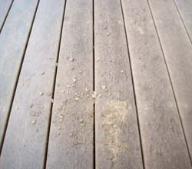 This picture was taken during a recent Home Inspection at a Sequim residence. The house and deck were built in 2004 and illustrate some of the onsite conditions that clients in this area are facing when purchasing a home with a deck constructed with composite materials manufactured by various companies.
This picture was taken during a recent Home Inspection at a Sequim residence. The house and deck were built in 2004 and illustrate some of the onsite conditions that clients in this area are facing when purchasing a home with a deck constructed with composite materials manufactured by various companies.
Splitting/ Cracking/Crumbling:
Have you noticed any decks with damage that appears like this? The first picture was provided by Louisianan Pacific on their website and shows the deterioration of the decking boards at the cut end and point of attachment to the support joists. The trade name is Veranda and is locally sold at Home Depot and has been widely used by home owners and some contractors to renovate an aging deck on older homes and on some new construction projects.
The other two pictures were taken during recent Home Inspection of a Sequim residence built in 2004 and again show damage due to the deterioration and failure of these types of products that clients are questioning during inspections.
Louisiana-Pacific Corporation (LP Building Products) (LP) LPX today issued a product advisory for composite decking materials purchased after January 1, 2005, and made by LP at its Meridian, Idaho facility.
Some of the product can prematurely deteriorate and break, posing a risk of injury to consumers. LP decking products, including deck board and railings sold under the names of LP WeatherBest®, WeatherBest®, ABTCo and Veranda® are subject to this advisory. The products are used for building outdoor decks. LP has received claims of premature deterioration of a small portion of its decking product due to variations in manufacturing processes in this time frame.
LP Executive Vice President of Specialty Products and Sales Rick Olszewski said, “We want consumers to be aware of the potential risk of injury, and to contact us. Though only a small portion of decking sold has been affected by these issues, we urge people who bought or installed these composite decking products after January 1, 2005 to contact us for an inspection through our decking notice Web site or customer service line.”
The decking advisory Web site is at www.deckingnotice.com.
Mold, mildew and mold spots similar to these pictured are common on composite decking in this area. This is just not a Pacific Northwest problem but very well can be a product defect. Proper cleaning is essential in maintaining not just the look of the deck but in extending the life expectancy of the decking- see page 4.
Trex Settles Product Lawsuits –September 14, 2004
Trex and Exon-Mobil (the former owner of Trex) have agreed to settle a class action lawsuit. The suit claimed that Trex decking rotted, splintered and degraded, contrary to widespread advertising and marketing claims by the company, and that Trex failed to live up to its warranties against product defects. After initially calling the lawsuit “frivolous”, Trex agreed to stop all advertising claims that its deck products do not require sealant and are maintenance-free. Trex also agreed to replace any defective product sold between 1992 and 2004. For more information, contact 1-800-289-8739 begin_of_the_skype_highlighting 1-800-289-8739 end_of_the_skype_highlighting or question@trex.com.
Trex settled a similar suit by one of its large distributors in 2000 for fraudulent business practices in which it was claimed that Trex materials tended to “disintegrate, crumble, turn pink, turn blue, spot, bubble, blister, contain lumps, contain hidden defects such as metal objects .., or grossly warp if exposed to sunlight or weather” and that the company failed to honor its warranty. The actual settlement terms are secret.
GeoDeck Products Recalled- August 16, 2005
Proving that not even the best product testing is fool proof, the GeoDeck composite decking products top rated in 2004 by Consumer Reports have been recalled for safety issues. The Consumer Products Safety Commission announced a voluntary recall of certain GeoDeck products for dangerously rapid degradation, especially in hot climates. Although no-one has yet been hurt, the recall was prompted by several hundred confirmed reports of composite deterioration to an unsafe condition.For more information and to see if your deck qualifies for the recall, visit GeoDeck Recall Information.
Mold/Mildew:
Cleaning Composite Decking
WARNING:
Chlorine Bleach or Sodium Hypochlorite (active ingredient in Chlorine Bleach) based deck cleaners may appear to quickly remove mildew (white in color) and mold (black and other colors) fungus from Trex and other Composite Decking. Nothing could be farther from the truth.
The Environmental Protection Agency (EPA) and the Occupational Safety & Health Administration (OSHA) DO NOT RECOMMEND Chlorine Bleach for Mold (Mildew is a species of Mold) remediation on porous surfaces such as Trex and other composite decking.
The reason for this is that Chlorine Bleach does not remove or kill the roots (mycelium) of the fungus, but actually waters them. A few weeks after you have cleaned a deck with chlorine bleach or sodium hypochlorite based products you will notice the mildew or other mold fungus growing back in greater numbers, especially after additional moisture comes into contact with the deck. It will make the problem worse and harder to remove the next time the composite surface becomes unsightly.
In addition, Chlorine Bleach products shorten the life expectancy of the rest of the deck structure. It is corrosive to any metal including structural connectors or fasteners (screws) holding the deck together. It shortens the life of the pressure treated lumber supporting the deck. This could lead to liability issues for the owner of the property and any company who recommends its use.
RECOMMENDATION: Clean deck surfaces with an approved product such as but not limited to the following listed products.
CORTE CLEAN® ECO-FRIENDLY Composite Deck, Dock & Fence Cleaner is an amazing solution for easily cleaning composite stains resulting from Mold (mould), Mildew, Black Spots, Grease, Oil, Barbecue (BBQ), Tannin(s) (black Wood Fibers), Leaf, Chalk, Berries, Sunscreen, Olive Oil, Citronella Candle Oil, Peanut Butter, Red Wine, Hard Water, Grass, Ground in Dirt, Iron (red dirt), Rust, Clay, Grime, Slime and most other stains that have saturated into a composites porous or non-porous surface. See www.corteclean.com
MESSMER’S COMPOSITE DECK CLEANER, Many owners of composite decks have been disappointed in their appearance as they weather over time. Some of these materials quickly fade to an unattractive gray color, but you can restore your deck’s appearance with Messmer’s Composite Deck Finish. See www.messmers.com
We thank Tyler Conkle for his contribution. Tyler is a Home Inspector with Vanguard, and you can find him on his website at http://www.vanguardinspect.com.
Last Updated on December 5, 2023 by Chuck Marunde


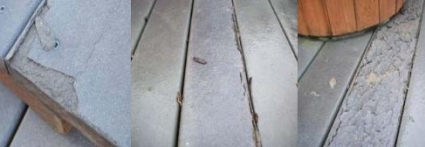
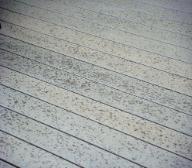
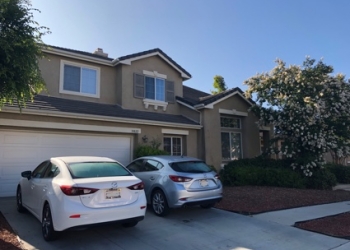
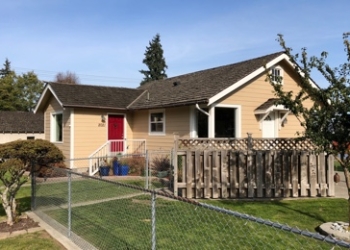
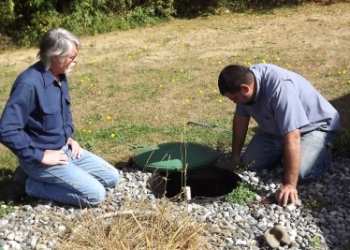
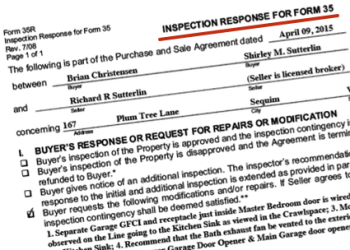
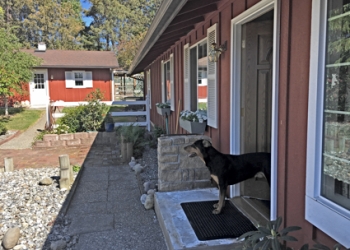
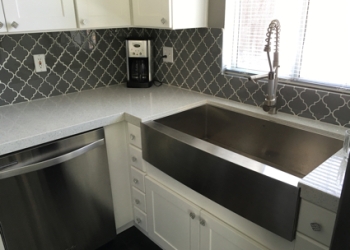



























Thanks you for this post. Very helpful. Please keep writing, because my wife and I read your blog weekly.
There is a lot to like about Trex–it’s environmentally friendly and seems to be really durable.
Great post. Very helpful.
My brother has a deck that has been completely wrecked by weather damage. It’s to the point where it can’t even be repaired, but needs to be replaced. I would never expect that could happen to a structure so quickly.
Thank you a bunch for sharing this about composite decking. Appreciated the read.
Composite materials could be the way of the future, especially if they can keep their colour. this will also be brilliant for the environment. I hope that the coposite materials will be able to be recycled with ease, unlike plastic, where the plastics have to be separated. If they get this right then I,m sold.
I appreciate you posting on this topic. I have learned that metal building and steel buildings are one of the best type of homes or buildings. However, this article also taught me a lot as well. Thank you again.
Great article! Lots of information on composite decking, really helpful!
I read about Sequim Washington years ago in a magazine, and I remember thinking I should take a trip to Sequim and see if there are some nice homes. I’m retiring soon, so I’ll be looking online with your help, and thank you for making it fun. Your Sequim real estate blog is the best Sequim resource.
We actually sold a place with problems on the decking, but we did inform the buyers of it and they were ok with it. So I guess it is just about communicating rightly
What does a special deck cleaner for mold removal contain? How often would you have to clean a deck with it and what protective gear would you have to wear using them?
Thanks for your great article,
Tony
Composite decking is very attractive but not all composite decking materials are the same. As you start to analyze composite decking prices when you actually touch and feel composite wood decking samples, be sure you ask very pointed questions about what the manufacturer includes in the composite decking to prevent wood rot.
Roofs play a key role in protecting building occupants and interiors from outside weather conditions, primarily moisture. The roof, insulation and ventilation must all work together to keep the building free of moisture. Roofs also provide protection from the sun. In fact, if designed correctly, roof overhangs can protect the building’s exterior walls from moisture and sun. The concerns regarding moisture, standing water, durability and appearance are different, reflected in the choices of roofing materials.
It certainly is a very good tip. I’ve been having so much problems with this. Great article. I must say. Thanks a lot for the effort. Appreciate it. Cheers
While a home inspection is not required by law in Washington, it certainly is wise for a buyer to hire a home inspector to examine the home and discover any possible major problems that may effect their desire to complete the purchase.
Here is a great article that is really helpful with choosing the best type of composite decking!
Interesting article indeed. Now it all makes sense. I have few friends who have similar problems in there decks and they were quite lost on why it is happening. Thanks for the article. I will surely share this with them. Cheers
Composite decking has also evolved due to demand for decks and companies that want to seize the opportunity for a market share and to make some money. Composites are a combination of two or more materials, usually sawdust or wood fibers and plastic. Some big companies decided to put waste sawdust and recycled plastics together to create a product. The use of recycled products is great.
Great article on composite decking. Probably one of the best articles I’ve read on the subject.
Very informative and helpful, hope your great articles continue. My friend told me about this site and it has lived up to expectations so far.